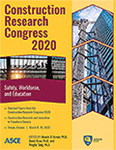Construction Research Congress 2020
Safety Performance of a Fatigued Construction Worker
Publication: Construction Research Congress 2020: Safety, Workforce, and Education
ABSTRACT
The construction industry has a high rate of fatal and non-fatal occupational accidents. Every year, over 60,000 construction workers lose their lives due to accidents in the workplace. Construction workers often face safety and health risks performing construction activities in hazardous environments. In addition, construction activities are demanding which in turn can lead to fatigue. In fact, fatigue is one of the leading causes of construction accidents. To prevent accidents, workers must be able to recognize hazards in their workplaces and perceive associated safety risk. This study aimed to empirically investigate the impact of fatigue on construction workers’ hazard recognition and safety risk perception. To achieve the research goals, 135 construction workers were recruited. First, the workers’ level of fatigue was measured using OFER scale. Then, their hazard recognition and safety risk perception were evaluated using pre-evaluated case images all captured from real construction projects. The results of the study revealed (1) a correlation between fatigue and hazard recognition and (2) a significant correlation between fatigue and safety risk perception. This research is the first endeavor to empirically study the impact of fatigue on safety performance (i.e., hazard recognition and safety risk perception) of construction workers. The findings of this article will be beneficial for professionals and practitioners who are seeking effective measures to improve the safety performance of workers in construction.
Get full access to this article
View all available purchase options and get full access to this chapter.
ACKNOWLEDGMENTS
The authors would like to extend their sincere appreciation to the project managers and construction workers who assisted and participated in this research study. This research effort would have not been possible without their help, support, and contribution.
REFERENCES
Albert, A., Hallowell, M. R., and Kleiner, B. M. (2013). "Enhancing construction hazard recognition and communication with energy-based cognitive mnemonics and safety meeting maturity model: Multiple baseline study." Journal of Construction Engineering and Management, 140(2), 04013042.
Albert, A., Hallowell, M. R., and Kleiner, B. M. (2014). "Experimental field testing of a real-time construction hazard identification and transmission technique." Construction Management and Economics, 32(10), 1000-1016.
Fang, D., Jiang, Z., Zhang, M., and Wang, H. (2015). "An experimental method to study the effect of fatigue on construction workers’ safety performance." Safety Science, 73, 80-91.
Fung, I. W., Tam, V. W., Lo, T. Y., and Lu, L. L. (2010). "Developing a risk assessment model for construction safety." International Journal of Project Management, 28(6), 593-600.
Hatami, F. (2013). "The effects of a safety educational intervention on promoting safety behavior at textile workers." Hormozgan Medical Journal, 17(4), 333-345.
Namian, M., Albert, A., and Feng, J. (2018). "Effect of distraction on hazard recognition and safety risk perception." Journal of Construction Engineering and Management, 144(4), 04018008.
Namian, M., Albert, A., Zuluaga, C. M., Behm, M. (2016a). "Role of Safety Training: Impact on Hazard Recognition and Safety Risk Perception." J. Constr. Eng. Manage., 142(12), 04016073.
Namian, M., Albert, A., Zuluaga, C. M., and Jaselskis, E. J. (2016b). “Improving Hazard-Recognition Performance and Safety Training Outcomes: Integrating Strategies for Training Transfer.” Journal of Construction Engineering and Management, 142(10), 04016048.
Namian, M., Zuluaga, C. M., and Albert, A. (2016c). “Critical Factors That Impact Construction Workers’ Hazard Recognition Performance.” Construction Research Congress 2016.
Naranjo-Flores, Arnulfo Aurelio, and Ernesto Aurelio Ramírez-Cárdenas. (2014). “Human Factors and Ergonomics for Lean Manufacturing Applications.” Lean Manufacturing in the Developing World, 2014, 281–99. https://doi.org/10.1007/978-3-319-04951-9_13.
Parijat, P., and Lockhart, T. E. (2008). "Effects of lower extremity muscle fatigue on the outcomes of slip-induced falls." Ergonomics, 51(12), 1873-1884.
Swaen, G., Van Amelsvoort, L., Bültmann, U., and Kant, I. (2003). "Fatigue as a risk factor for being injured in an occupational accident: results from the Maastricht Cohort Study." Occupational and environmental medicine, 60(suppl 1), i88-i92.
Techera, U., Hallowell, M., Littlejohn, R., and Rajendran, S. (2018). "Measuring and Predicting Fatigue in Construction: Empirical Field Study." Journal of Construction Engineering and Management, 144(8), 04018062.
Tixier, A.J.-P., Hallowell, M. R., Albert, A., van Boven, L., and Kleiner, B. M. (2014). "Psychological antecedents of risk-taking behavior in construction." Journal of Construction Engineering and Management, 140(11), 04014052.
Weick, K. E., Sutcliffe, K. M., and Obstfeld, D. (2008). "Organizing for high reliability: Processes of collective mindfulness." Crisis management, 3(1), 81-123.
Williamson, A., Lombardi, D. A., Folkard, S., Stutts, J., Courtney, T. K., and Connor, J. L. (2011). "The link between fatigue and safety." Accident Analysis & Prevention, 43(2), 498-515.
Winwood, P. C., Winefield, A. H., Dawson, D., and Lushington, K. (2005). "Development and validation of a scale to measure work-related fatigue and recovery: The Occupational Fatigue Exhaustion/Recovery Scale (OFER)." Journal of Occupational and Environmental Medicine, 47(6), 594-606.
Yung, Marcus, Philip L. Bigelow, Darnell M. Hastings, and Richard P. Wells. (2014). “Detecting within- and between-Day Manifestations of Neuromuscular Fatigue at Work: an Exploratory Study.” Ergonomics 57, no. 10, 1562–73. https://doi.org/10.1080/00140139.2014.934299.
Zhang, M., Murphy, L., Fang, D., and Caban-Martinez, A. J. (2015). "Influence of fatigue on construction workers’ physical and cognitive function." Occupational Medicine, 65(3), 245-250.
Information & Authors
Information
Published In
Construction Research Congress 2020: Safety, Workforce, and Education
Pages: 591 - 598
Editors: Mounir El Asmar, Ph.D., Arizona State University, David Grau, Ph.D., Arizona State University, and Pingbo Tang, Ph.D., Arizona State University
ISBN (Online): 978-0-7844-8287-2
Copyright
© 2020 American Society of Civil Engineers.
History
Published online: Nov 9, 2020
Published in print: Nov 9, 2020
Authors
Metrics & Citations
Metrics
Citations
Download citation
If you have the appropriate software installed, you can download article citation data to the citation manager of your choice. Simply select your manager software from the list below and click Download.
